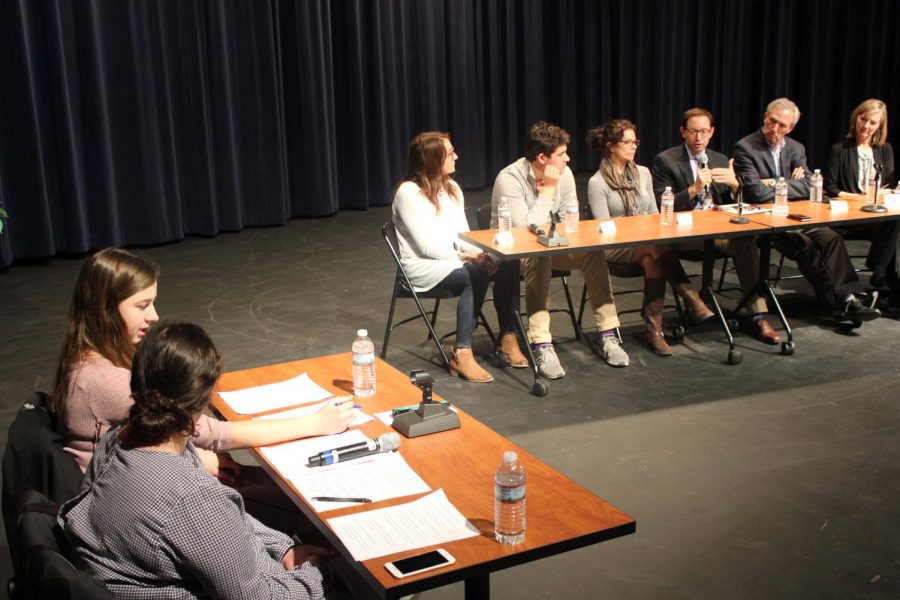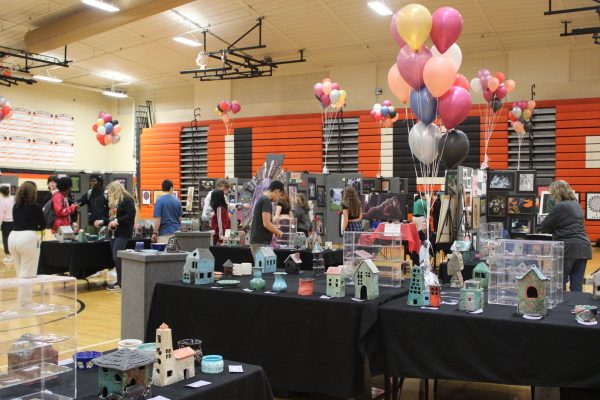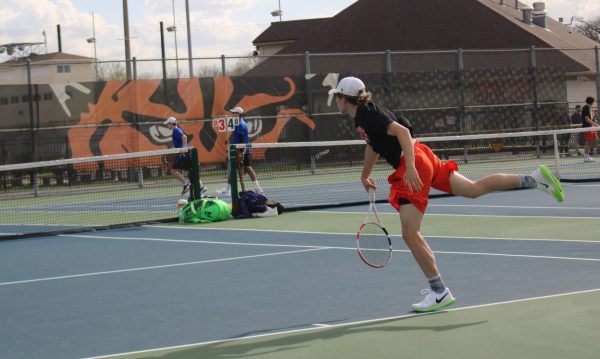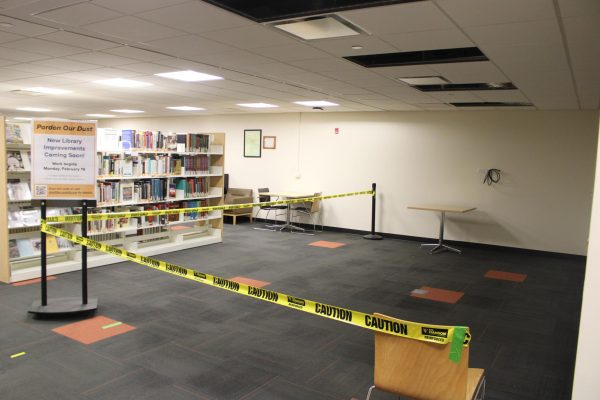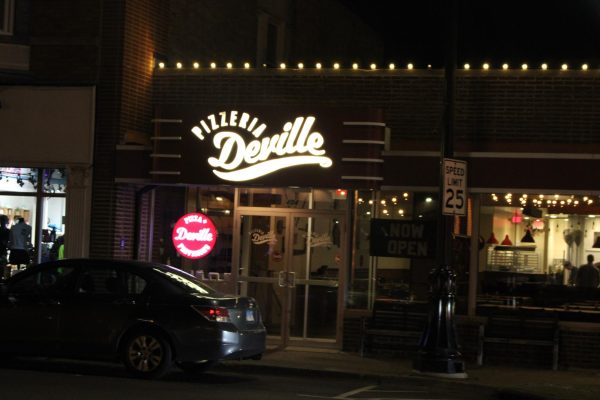Drops of Ink hosts community school safety discussion
On Tuesday, April 17, students, school employees, and a district school board member discussed the safety of Libertyville High School and its students in the Studio Theater. Facilitating the discussion were the Drops of Ink Editors-in-Chief: Hannah Hutchins and Maria Thames.
This panel discussion was motivated, as stated by Hutchins and Thames at the event’s outset, in light of recent events: the Marjory Stoneman Douglas High School shooting on Feb. 14, which resulted in the death of 17 people. In the timing of the discussion, there was another significance: the upcoming anniversary of the April 20, 1999, Columbine High School shooting.
When tragedies occur, it’s really easy to feel removed and to think that something like this could not happen to us, but in this day and age, these [are] conversations we feel we have to have because these situations could occur
— Hannah Hutchins
“When tragedies occur, it’s really easy to feel removed and to think that something like this could not happen to us, but in this day and age, these [are] conversations we feel we have to have because these situations could occur,” said Hutchins.
The panel consisted of seven individuals, all probed with questions from Hutchins and Thames; each brought their respective perspectives to the discussion. Those participating on the panel were Kathryn Hay and Zachary El-Ghatit, LHS juniors; Ms. Dyan Naslund, English teacher; Dr. Tom Koulentes, LHS principal; Mr. Pat Groody, District 128 Board of Education president; Dr. Brenda Nelson, school wellness and prevention coordinator; and Mr. Dusan Racic, school resource officer.
The discussion did not allow for audience participation. However, audience members were encouraged to contact Dr. Koulentes with any comments or concerns afterward.
A primary topic of the discussion was the current preventative measures at LHS to maximize safety. Dr. Koulentes stated a number of different measures are under “two broad categories: [the] physical structure of the building and [the] educational curriculum.”
The LHS building itself is considered to be “one of the safest high schools in the state in terms of the physical plant,” which allows for the prevention of school-natured threats, according to Dr. Koulentes. This was further re-iterated by Officer Racic.
Safety technology, equipment and personnel that the district and school board have heavily invested in are what add to the majority of LHS safety precautions. Some examples include people on the LHS Campus Safety Team, which includes Officer Racic. Other safety measures consist of video surveillance and monitoring; doors and a fob lock system; 3M bullet-resistant glass near entrances; and bollards (steel and concrete blocks at each of the main entrances). Practices such as lockdown drills, which occur three times a year, are other measures in effect at LHS.
Lockdown drills are seen as vital to not only prepare the students and staff but also for security improvement. For example, Dr. Koulentes shared that there will be the addition of two more door locks in the building, as a result of information gathered in the most recent lockdown drill.
I would feel less safe with a gun in my classroom. Even if I was trained on it, there are so many things [that] I could imagine going wrong
— Ms. Dyan Naslund
Mr. Groody expressed that while amongst Board of Education members there is often division on some issues at hand, they all are united in protecting the students and staff of D128 as much as possible, which is why there are so many precautions taken at LHS already.
Motivated by the details of the Stoneman Douglas shooting, which occurred amidst a false fire alarm to create more confusion and possibly more casualties, LHS and D128 officials prompted a conversation with the Libertyville Police and Fire Departments to discuss the legality and regulations for fire alarms to prevent a similar instance from occurring here. Officer Racic said there are discussions to possibly change future procedures regarding fire alarms, on an Illinois public school level, but nothing has been established yet.
A major part of the aforementioned educational curriculum relating to school safety is promoting good mental health practices, which often occur through the Learning Support Teams. Dr. Koulentes described the curriculum as comprehensive and further developing, which supports students’ mental and social-emotional health, combined with the LSTs as resources.
Other preventative movements at LHS include the Green Dot Program. Hay and El-Ghatit participated in the initial training for this program earlier this school year and both spoke briefly about their experiences.
When discussing a hypothetical active-shooter situation at LHS, Hay and El-Ghatit expressed that they felt comforted by teachers in their conversations in response to the Stoneman Douglas shooting.
Ms. Naslund added: “I don’t think you can ever really be 100 percent prepared, but you certainly can at least know that you’re doing the things that would help you be mostly prepared. I think that there’s a really important balance between feeling safe but also remaining vigilant.”
While there are active national debates on arming teachers with various weapons in the classroom as additional prevention measures, several members of the discussion expressed distrust, discomfort and confusion with that idea, specifically if it was to be implemented at Libertyville High School.
“I would feel less safe with a gun in my classroom. Even if I was trained on it, there are so many things [that] I could imagine going wrong,” said Ms. Naslund.
Furthermore, the addition of metal detectors or clear backpacks at LHS were considered to be unworthy because of the possible negative emotional effects for students and staff, coupled with doubt that metal detectors will make a given school any safer.
“I don’t foresee [clear backpacks or metal detectors] being something we are moving towards at Libertyville anytime soon,” said Dr. Koulentes.
Looking to the future and safety of LHS, various panel members argued that they would not want any preventative measures to be taken that would drastically affect or prohibit the school environment.
“I think the more measures we have, the more secure we feel we are and the more complacent we may become. I still believe [a] key element to this thing is that we always have to be aware, we always have to be alert, we always have to think smart,” said Mr. Groody.
To bring more awareness of these ideas to the student body, junior Layan Abdo, who attended the discussion, proposed having another school safety discussion during the school day, if possible.
“I loved [the school safety discussion]. I don’t know how much change it will cause, but I think it will definitely make people feel more secure that our school is a safe place,” said Abdo.



